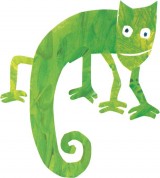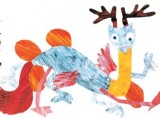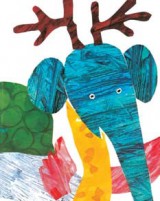Eric Carle’s The Mixed-Up Chameleon presents the perfect context for Jonathan Lear’s playful science project with an artistic twist...
The Mixed-Up Chameleon is one of Eric Carle’s best loved children’s books. It tells the story of a chameleon who leads an uneventful life, until the day he comes across a zoo. Amazed by all of the beautiful animals, he wishes for some of the qualities of the creatures he sees. To his delight, his wishes come true.
The chameleon becomes big and white like a polar bear, handsome like a flamingo, and strong like an elephant – each time taking on a physical characteristic of the animal he has just seen. Before long, the chameleon is an incredible mix of creatures but discovers that he is no longer able to catch his favourite meal – a fly. With his final wish, he returns to being a chameleon, catches the fly, and reminds us all why it’s important to be yourself.
It’s a great story to use with all year groups, and there are many different areas that can be explored using The Mixed-Up Chameleon as a context. For instance, the following mini topic could be spread over a half term, or delivered in one or two action packed weeks. The children will relish the opportunity to create something unique, and thanks to our ambitious little chameleon, will have a great time doing it.
Start muddling mammals and randomising reptiles…
One of my favourite uses for this story is to explore habitats, interdependence and adaptation.
 Read the book to the children. If you are feeling brave, you could act out the various animals whose features are slowly added to the chameleon; it’s a bit like trying to play ten games of animal charades all at the same time – exhausting, but entertaining for the audience! You could always get the children to try this. Each child who comes to the front has to add the relevant part to the chameleon until he is completely mixed-up.
Read the book to the children. If you are feeling brave, you could act out the various animals whose features are slowly added to the chameleon; it’s a bit like trying to play ten games of animal charades all at the same time – exhausting, but entertaining for the audience! You could always get the children to try this. Each child who comes to the front has to add the relevant part to the chameleon until he is completely mixed-up.
When the story is finished, challenge the children to come up with their own mixed-up animal. In pairs or individually, sketch, draw or paint a new creature that is made up of several different parts. At this point, it is a good idea to restrict the number of animals used to three or four. More can be added later. This first session is merely a starting point for the learning that is to come – something to grab the imagination. There is no need to provide any science or specific art focus just yet. Let their imaginations run wild.
When the creatures are completed, they will need to be named; I find that Latin is the way to go…Elephanticrocodilifishysaurus!
And now for the science bit…
 Now that the children have had the opportunity to create their own mixed-up creatures, it is time to see just how much they really know about their new pets. In groups, have pupils come up with a series of questions they could ask to find out more about their creature: Where would it live? What would it eat? What conditions is it suited to?
Now that the children have had the opportunity to create their own mixed-up creatures, it is time to see just how much they really know about their new pets. In groups, have pupils come up with a series of questions they could ask to find out more about their creature: Where would it live? What would it eat? What conditions is it suited to?
When the questions have been generated, they can be used by the children to think in more detail about their pet. Initially, you may get imaginative rather than scientific answers, so encourage them to use what they know about the animals to describe potential habitats or feeding relationships. During the course of the activity, children will naturally begin to split the animals – ‘that bit’s from a camel, it would live in the dessert, but this bit is from a crocodile – it needs to live in a river.’ (If this does not happen you will need to prompt the children – it is important that they deal with each animal separately.)
As they begin to exhaust their knowledge, ask the children how they might find out more about the animals they have used. Could they look at reference books, encyclopaedia, the internet? Challenge pupils to answer as many questions as possible about the animals that make up their creature. Post-it notes are ideal for recording information found as they can be positioned around the drawings to act as labels for the different parts.
As this activity leads to a greater understanding of habitats and food chains, some children decide to change their original creature – one girl decided the carnivorous nature of a tiger might upset the sensitive vegetarian zebra that it was attached to. She changed her mixed-up creature so that it was formed purely from plant eating herbivores.
Create a hybrid home…
Although the children have developed their knowledge of habitats, interdependence and adaptation, the real test is still to come. We have created incredible mixed-up creatures, researched the component animals, and even named them, but what do we do with them now? The creatures must live somewhere, but with such a mix of animals, what would the ideal habitat look like?
In this activity, children are challenged to design an enclosure for their mixed-up creature. It must meet the needs of every animal used in order for them to survive. All of the children’s knowledge and research will be needed to create a habitat that will support their creature. The design may start by looking at the basic habitats that each animal requires – it could develop to include other animals that would form part of the mixedup creature’s food chain.
Throughout this process, it is vital that children justify and support their ideals with reference to their learning, ‘I’m putting a river through this section of the enclosure because part of my mixed-up creature is a freshwater crocodile. Next to the river I’ve put a sandy bank because my creature has camel’s feet – they are specially adapted for walking on sand.’
To complete the design, children can add labels to explain the different features they have included.
Activity four build your own safari park…
 A great way to celebrate the children’s work at the end of this topic is to open a zoo or safari park to members of the school and parents. Ideally, children will work in small groups on a fairly large scale. Each team, or group, is given one of the creatures to work with, and they must carefully follow the design to recreate the enclosure (complete with mixed-up creature) in the classroom, school hall or grounds.
A great way to celebrate the children’s work at the end of this topic is to open a zoo or safari park to members of the school and parents. Ideally, children will work in small groups on a fairly large scale. Each team, or group, is given one of the creatures to work with, and they must carefully follow the design to recreate the enclosure (complete with mixed-up creature) in the classroom, school hall or grounds.
Materials used would depend on location. An advantage of working outdoors is that a combination of natural and man-made materials can be used, e.g. rocks for a mountainous area, blue fabric for the sea. An obvious disadvantage would be the weather!
Wherever the location, each enclosure will show the different sections needed by the mixed-up creature. When the habitats are completed, the children act as safari guides, taking groups of visitors around their zoo and sharing their knowledge of the incredible creatures that live there.
Make every lesson an experiment
Cross Curricular
Teaching five year olds to talk
Ace-Classroom-Support
Use coaching to turn failures into learning success
Ace-Classroom-Support
